Essential Tips for Maintaining Your Coffee Maker
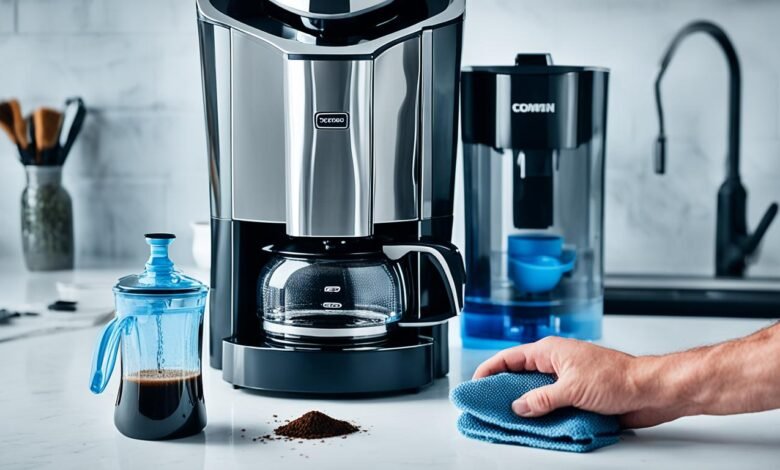
As a self-professed coffee connoisseur, I know the importance of a well-maintained coffee maker. That perfect cup of joe is the catalyst that kickstarts my day and fuels my creativity. However, like any appliance, our beloved coffee makers require regular attention to ensure they continue to deliver that delightful brew we crave.
In fact, did you know that approximately 64% of adults in America drink at least one cup of coffee per day? With such widespread consumption, it’s crucial to keep our coffee makers in top shape. This comprehensive guide will walk you through the essential tips and tricks to properly clean and maintain your coffee maker, from vinegar-based cleaning solutions to preventing future buildup.
Key Takeaways
- Regular cleaning is essential to prevent gunk buildup and disinfect your coffee maker.
- Descaling the coffee maker regularly can prevent limescale deposits from causing problems.
- Routine maintenance can help your coffee maker perform optimally for years to come.
- Vinegar is a safe and effective cleaning agent for coffee makers.
- Baking soda can also be used as an alternative to vinegar for cleaning.
The Importance of Regular Coffee Maker Cleaning
Germs and Bacteria Buildup
When it comes to maintaining your coffee maker, regular cleaning is crucial. Studies have shown that coffee makers can be one of the germiest places in the home, with up to 50% of reservoirs containing yeast and mold. These microorganisms can not only affect the taste of your coffee but also pose health risks, causing allergic reactions or even infections.
Regular cleaning with vinegar not only sanitizes the machine but also helps dissolve any mineral deposits or buildup that can impact the performance and longevity of your coffee maker. Approximately 99% of a cup of coffee is water, making it a crucial element in brewing a good cup of coffee. However, water can also carry minerals like calcium and magnesium that accumulate on the coffee machine’s heating element, forming limescale if not descaled regularly.
Mineral scale buildup can impact the machine’s boiler, affecting the optimal brewing temperature and water flow, potentially leading to your coffee not being as hot as it should be. Failure to descale a coffee maker can also cause the machine to not brew hot enough, impacting the overall flavor of your coffee.
In addition to mineral buildup, coffee itself is an oily substance that can accumulate residue inside the machine over time, affecting the taste of the brewed coffee. Untreated residue can cause bitter-tasting coffee, unpleasant smells, clogging, and potentially render the machine unusable.
“Regular cleaning and descaling are essential to ensure coffee machines operate at their best, producing flavorful and hot coffee, and extending their lifespan.”
By maintaining your coffee maker through regular cleaning and descaling, you can prevent the growth of yeast and mold, ensure optimal brewing temperature and water flow, and enjoy consistently great-tasting coffee while extending the life of your machine.
Cleaning Your Coffee Maker with Vinegar
Maintaining a clean coffee maker is essential for brewing a flavorful cup of coffee. One of the most effective and affordable solutions for this task is using vinegar. The acid components in vinegar can effectively remove leftover coffee oils, stains, and lime scale or mineral deposits that have built up inside the machine.
To clean your coffee maker with vinegar, you’ll want to use a 50/50 solution of white vinegar and water. This solution can be run through a cleaning cycle to thoroughly clean and descale your coffee maker. According to experts, a deep cleaning to remove mineral deposits should be done at least every three months, or even more frequently for those with hard water or who refill the water reservoir from a rinsed carafe.
- Prepare the vinegar solution by mixing equal parts white vinegar and water.
- Run the vinegar solution through a brew cycle, allowing it to fully cycle through the machine.
- Once the cycle is complete, run several cycles of plain water to rinse away any lingering vinegar scent.
Vinegar is a preferred choice for cleaning coffee makers, as it is an effective, eco-friendly, and safe alternative to harsh chemicals. It can help remove built-up bacteria, mold, and mineral deposits, ensuring your coffee maker operates at its best and your coffee tastes fresh and flavorful.
Regular cleaning with vinegar, combined with proper maintenance of your coffee maker, can help extend its lifespan and keep your daily coffee routine running smoothly. By taking the time to clean your coffee maker with vinegar, you can enjoy a better-tasting cup of coffee and avoid the hassle of dealing with a malfunctioning or dirty machine.
Step-by-Step Guide to Cleaning with Vinegar
Keeping your coffee maker in top condition is essential for brewing a delicious and flavorful cup of coffee every time. One of the most effective ways to clean your coffee maker is by using white vinegar. This all-natural solution can help remove built-up residue, scale, and bacteria that can negatively impact the taste of your coffee. Let’s explore a step-by-step guide on how to clean your coffee maker with.
Preparing the Vinegar Solution
Start by creating a 50/50 solution of white distilled vinegar and water. This ratio ensures the vinegar is strong enough to effectively clean your coffee maker without leaving behind a harsh vinegar taste.
Running the Vinegar Cycle
- Pour the vinegar solution into the coffee maker’s reservoir.
- Run a normal brewing cycle, allowing the solution to pass through the machine.
- Once the cycle is complete, let the vinegar solution sit in the carafe and reservoir for 30-60 minutes.
- Repeat the process with a fresh vinegar solution to ensure a thorough cleaning.
Rinsing Away the Vinegar Scent
After the vinegar cleaning cycles, it’s important to run several cycles of just water to flush out any remaining vinegar scent or taste. This will ensure your next cup of coffee tastes fresh and delicious.
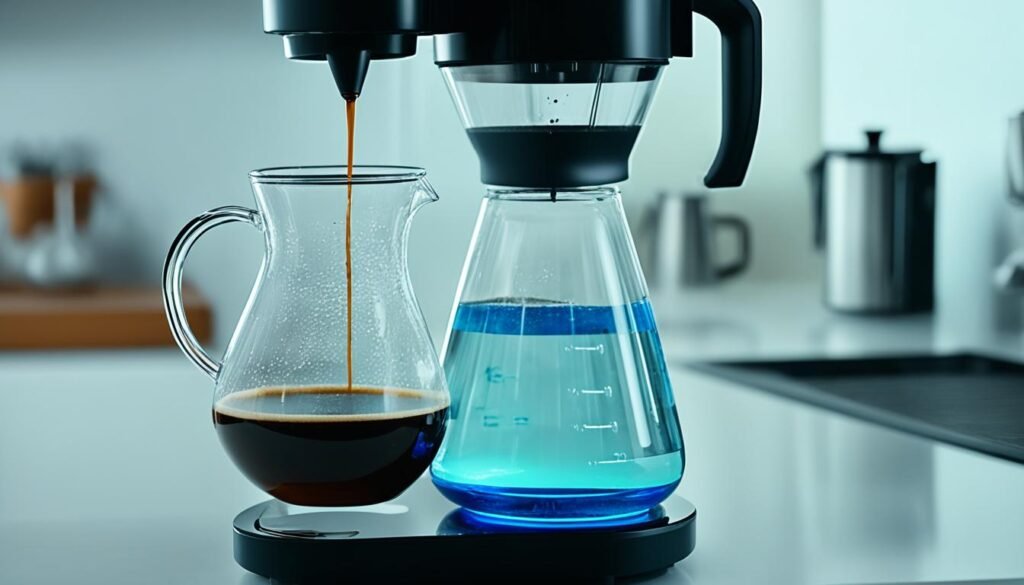
“Cleaning the coffee maker with vinegar every three months is recommended to prevent mineral build-up in the machine, which can slow down the brewing process.”
By following this step-by-step guide, you can effectively clean your coffee maker with vinegar and maintain its performance for a consistently great cup of coffee.
Coffee Maker Maintenance
Maintaining your coffee maker is crucial for prolonging its lifespan and ensuring a consistently great-tasting cup of coffee. In addition to regular cleaning, there are several other essential coffee maker maintenance tips to keep your machine in top condition.
Firstly, it’s recommended to avoid leaving the coffee maker on all day, as this can wear out the machine prematurely. Descale the machine regularly to remove mineral buildup, which can hinder the brewing process and affect the flavor of your coffee.
Additionally, it’s important to address any visible damage or issues, such as cracked pots or burned power cords, immediately. Ignoring these problems can lead to further deterioration and potentially even safety hazards.
To ensure your coffee maker remains in peak condition, it’s a good idea to follow a consistent maintenance routine. This may include weekly deep cleanings, monthly descaling, and daily rinsing of removable parts. By taking these proactive steps, you can enjoy a well-maintained, long-lasting coffee maker that consistently delivers delicious, flavorful coffee.
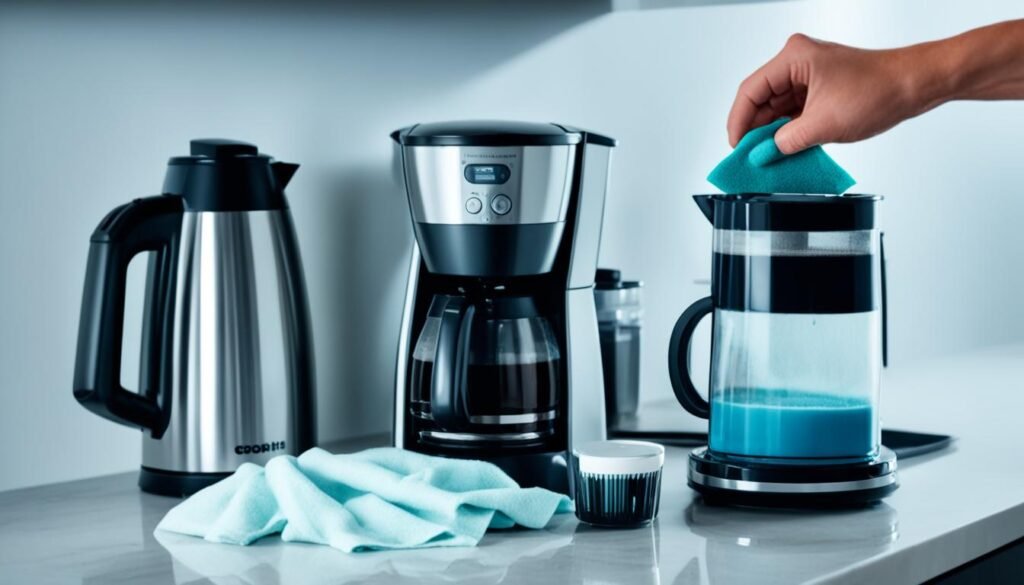
Remember, proper coffee maker care is the key to maintaining the quality and performance of your machine. By following these simple maintenance tips, you can keep your coffee maker running smoothly for years to come.
Cleaning Removable Parts
Maintaining your coffee maker goes beyond just the main brewing unit. The removable parts, such as the pot, lid, and filter basket, also require regular cleaning to keep your coffee tasting fresh and your machine operating at its best.
Experts recommend cleaning these removable components at least once a month if you use your coffee maker daily. For those who brew less frequently, a thorough cleaning every three months is advised, unless you notice visible buildup. Regular cleaning helps prevent the accumulation of coffee residue, hard water deposits, and bacterial growth that can impact the flavor and quality of your coffee.
To clean the removable parts, start by soaking them in a mixture of hot water and white vinegar or dish soap. Allow them to soak for up to an hour, then use a toothbrush or dishcloth to gently scrub away any remaining residue. Rinse the parts thoroughly and allow them to air dry before reassembling your coffee maker.
For a deeper clean, consider using a specialized coffee maker cleaner like affresh®. These products are designed to tackle tough mineral buildup and ensure your machine operates at peak performance. Running a brew cycle with the cleaner can help dissolve any remaining deposits within the internal components.
By dedicating a few minutes each month to cleaning the removable parts of your coffee maker, you’ll enjoy a better-tasting brew and extend the life of your appliance. Remember, a clean coffee maker is essential for maintaining the optimal flavor and quality of your coffee.
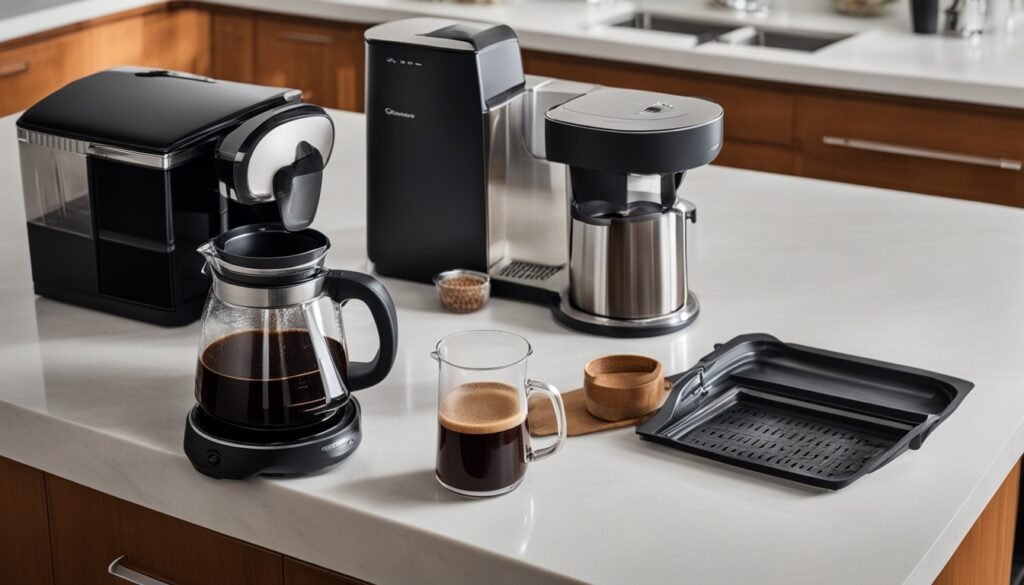
In addition to the removable parts, it’s also important to clean the water reservoir and other internal components of your coffee maker regularly. This helps prevent the buildup of mold, bacteria, and mineral deposits that can degrade the taste of your coffee and potentially compromise the functioning of your machine. By following a comprehensive cleaning routine, you’ll ensure your coffee maker continues to deliver a consistently delightful brewing experience.
Alternative Cleaning Solutions
While vinegar is a highly effective and affordable cleaning solution for coffee makers, there are also other options worth considering. Baking soda mixed with warm water can be used in a similar way to the vinegar solution, helping to break down and remove stubborn buildup. Additionally, there are specialized coffee maker cleaning products available that are designed to safely and thoroughly clean these appliances.
Baking Soda and Water
Baking soda is a natural and gentle abrasive that can effectively remove mineral deposits and residue from your coffee maker. To use this method, simply mix one-quarter cup of baking soda with a full water reservoir and run the brew cycle. The baking soda solution will help break down and flush out any accumulated buildup, leaving your coffee maker fresh and clean.
Specialized Coffee Maker Cleaners
For those who prefer a more specialized cleaning solution, there are a variety of commercial coffee maker cleaners available on the market. These products are designed specifically to tackle the unique challenges of cleaning coffee makers, including removing stubborn scale, oils, and residue. Many of these cleaners are also formulated to be gentle on the internal components of your appliance, helping to extend its lifespan.
Whether you choose to use baking soda, specialized cleaners, or a combination of cleaning methods, regularly maintaining your coffee maker is essential for ensuring a consistently delicious and healthy cup of alternative coffee maker cleaning solutions. By taking the time to properly baking soda coffee maker cleaning, you can keep your coffee maker in top condition and enjoy the perfect brew every time.
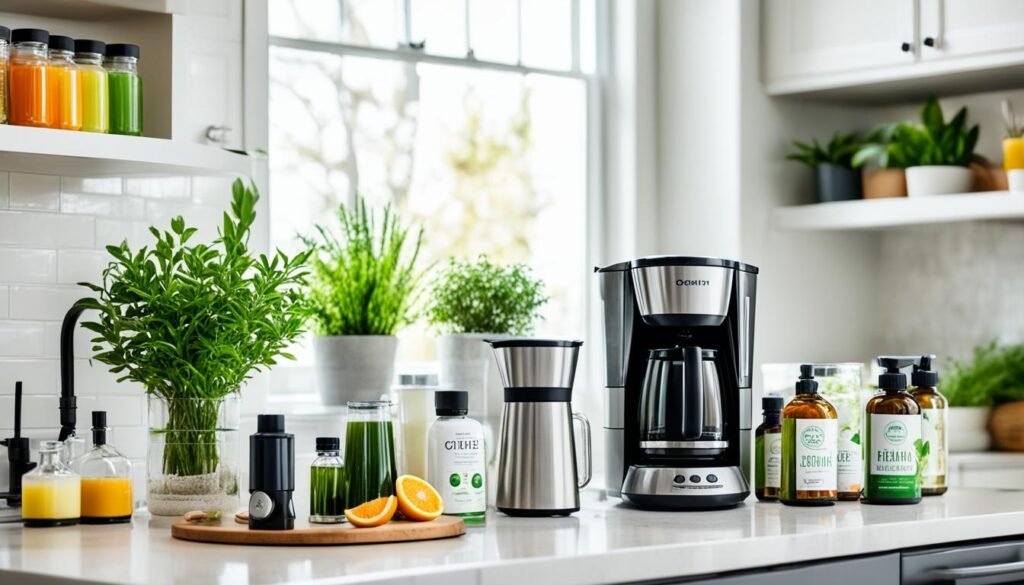
“Keeping your coffee maker clean is one of the best things you can do to ensure a great tasting cup of coffee every time.”
By incorporating specialty coffee maker cleaners into your regular maintenance routine, you can help prevent the buildup of harmful germs and bacteria, while also extending the life of your coffee maker. Invest in the health and longevity of your appliance by exploring these alternative cleaning solutions today.
Preventing Future Buildup
Maintaining a clean and well-functioning coffee maker is essential for brewing delicious, flavorful coffee consistently. To prevent future buildup and keep your coffee maker performing at its best, it’s important to establish a regular cleaning routine. Aim to clean the machine with vinegar or an alternative solution at least once a month, or more often if you use it daily.
In addition to periodic deep cleanings, there are several proactive steps you can take to avoid coffee maker residue and buildup:
- Empty the carafe after each use and avoid leaving coffee sitting in the pot for extended periods. The longer coffee sits, the more it can contribute to mineral deposits and staining.
- Use filtered water whenever possible. Tap water can leave behind mineral buildup that can clog internal components and affect the taste of your coffee.
- Store coffee beans in an airtight container to preserve their freshness and prevent oils from accumulating in the coffee maker.
- Use a paper filter to capture any remaining coffee grounds, reducing the frequency of deep cleaning the machine.
By implementing these simple preventative measures, you can maintain a clean, well-functioning coffee maker and enjoy consistently great-tasting coffee for years to come.
“Regular check-ups and annual part replacements can prevent corrective maintenance that may lead to the closure of a cafe.”
While regular cleaning is essential, it’s also important to keep an eye out for signs that your coffee maker may need a more thorough deep clean. If you notice visible buildup or residue, or if your coffee starts to taste off, it’s likely time to give your machine a more intensive cleaning.
Signs It’s Time for a Deep Clean
Keeping your coffee maker in top shape is essential for brewing a delicious cup of joe. While regular maintenance is important, there are a few key signs that indicate it’s time for a thorough deep cleaning. By recognizing these indicators, you can ensure your coffee maker continues to perform at its best.
Visible Buildup or Residue
If you notice visible buildup or residue around the pot, filter basket, or other parts of your coffee maker, it’s a clear sign that it’s time for a deep clean. This buildup can lead to off-flavors in your coffee and potentially even impact the function of your machine.
Off-Tasting Coffee
Another telltale sign that your coffee maker needs a thorough cleaning is if your coffee starts to taste different or off from its usual flavor profile. This could be a result of mineral deposits or other buildups that have accumulated within the machine, affecting the taste of your brew.
By keeping an eye out for these signs of signs coffee maker needs cleaning, indicators coffee maker needs deep cleaning, and addressing them promptly, you can maintain the coffee maker cleaning frequency necessary to keep your coffee maker in top condition.
“A clean coffee maker is the key to a consistently great cup of coffee.”
| Indicator | Explanation |
|---|---|
| Visible Buildup or Residue | Buildup around the pot, filter basket, or other parts indicates a need for deep cleaning. |
| Off-Tasting Coffee | Changes in the taste or flavor of your coffee can signal the presence of mineral deposits or other buildups. |
Conclusion
Maintaining a clean and well-functioning coffee maker is essential for brewing the perfect cup of coffee day after day. By following a regular cleaning routine, using effective solutions like vinegar, and addressing any visible buildup or performance issues, you can ensure your coffee maker continues to deliver consistent, fresh-tasting coffee for years to come.
Regular coffee maker maintenance is the key to unlocking the full potential of your machine and enjoying a consistently delicious brew. Take the time to clean your coffee maker thoroughly, and you’ll be rewarded with a superior coffee experience that elevates your daily routine. Remember, a well-maintained coffee maker is the foundation for a perfect cup of coffee, so invest in its long-term care for the best results.
Whether you’re dealing with mineral buildup, stale odors, or simply want to keep your coffee maker in top shape, the strategies outlined in this guide will help you maintain your coffee maker and ensure a superior coffee experience every time. Embrace the power of vinegar, baking soda, and other effective cleaning solutions to keep your coffee maker in peak condition and enjoy consistently delicious, freshly brewed coffee for years to come.






